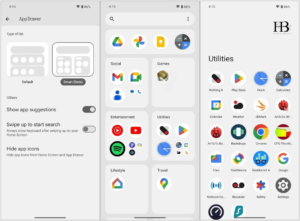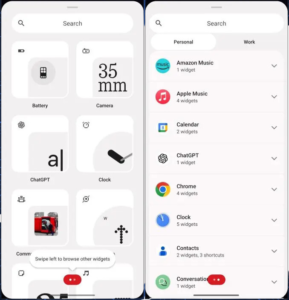It feels like yesterday when Nothing OS 3.0 made the announcement that they would be releasing a smartphone of their own. After three years, the London-based startup is getting ready to launch Nothing OS 3.0, which is built on Android 15. Here are my first thoughts after using the Nothing Phone (2a) with the Nothing OS 3.0 beta for more than a day.

In Nothing OS 3.0, the fast settings window has undergone a significant redesign. It now includes circular toggles that are more active in place of those huge pills.This is not only visually appealing but also appears more contemporary. You can enlarge these resizable toggles to access additional information if necessary.
The extended Bluetooth toggle, for instance, displays devices that are saved and those that are linked. Compared to earlier, you have greater control over how your quick setting is laid out. Up to 16 toggles can now be arranged on a single page, which is twice as many as before. One of my complaints was also resolved by Nothing OS 3.0, which provided a separate data toggle. I may now disable data without having to go the Wi-Fi settings.

I also adore how the brightness slider has thickened and moved to the bottom of the toggles. Compared to before, this makes it simple to grab and slide with one hand. The auto brightness toggle that the community has been asking for a while is also included. Unfortunately, though, when you collapse quick settings, the brightness slider remains absent. When this will be changed is unknown to me.
An “Intelligent” App Drawer

The home screen launcher of Nothing OS 3.0 now has a “Smart” app drawer. The new structure automatically groups your apps into distinct folders according to their functions, which is where the “smart” aspect comes from. Anyone who has an iPhone will quickly notice that this looks a lot like iOS’s App Library. I can tell that it’s essentially the same thing after utilizing it.

It is not possible to make new folders or move programs between folders. For some reason, I have two email apps that are in different categories, and there is nothing I can do about it. However, given that the Smart app drawer is marked as “Beta,” I anticipate that the company will eventually include customizing possibilities.
Additionally, you have the ability to pin your often used apps to the top of the drawer by using the app pinning feature. One of my favorite aspects of Nothing OS 3.0 at this point is this.
I can now pin my favorite apps, so app recommendations are no longer based just on speculation. It’s a simple yet clever innovation, and I’m surprised more OEMs didn’t think of it first.
Customizations for the Lock Screen

Nothing at all Changes are coming to OS 3.0 from the inside out. Thus, there are now more personalization options on the lock screen. Don’t get me wrong, though. Although I appreciate the OS’s present lock screen editing features, I don’t like that you have to go into settings to make modifications. This update resolves that, allowing you to modify the lock screen by long pressing on it.

Five new clock faces are available, each with a unique typography and style. There is now only one analog clock choice, thus I would have liked more. Now that the clock faces are hidden, you can extend the widget area. This lets you customize the lock screen with more widgets.
Another difference I enjoy is that, because of the restricted area, you had to be selective about which widgets I added. Additionally, the lock screen allows you to manually modify the left and right toggles.
A New Appearance for Settings

There’s also been some updating done to the Settings page. There are now sections for the menus and options. This lets you quickly access the options you want and also eases the strain on your eyes. Those who have been using Android for a long time will notice right away that this resembles the settings screen from Android 7.0 Nougat.
Additionally, a new option called “Special features” is available, with settings for RAM Booster, Game Mode, Pop-Up View, and Experimental features. I have to admit that the Nothing OS design team is making a lot of really smart choices. However, the Nothing OS 3.0 has made another big modification that some of you may favor and some may not.
An Error in the N-Dot Font
Upon utilizing the Nothing OS 3.0, I promptly observed that the renowned N-dot font from Nothing was conspicuously absent from the user interface. The N-dot font has vanished from the operating system entirely, from the setup screen to the settings page. This modification felt a little strange coming from the older version because the N-dot typeface is so integral to Nothing OS’s identity. However, the corporation made a conscious choice to move to a stylish sans-serif typeface.

This is because the text is easier to read. Despite being synonymous with Nothing and matching clock faces, app icons, and widgets, N-dot can be hard to read in some places and seems out of place with the rest of the interface—at least in my experience. The menus and UI options look good with the new, user-friendly font. I didn’t want to switch back to the old typeface because I rapidly grew accustomed to it.
It’s not like the business is abandoning dot matrix entirely, though. Rather, they are employing it in more inventive ways. Along with apps and widgets, they are launching a new Interactive Dot Matrix animation engine for the user interface. A preview of it was shown during the Nothing OS 3.0 launch, along with the new weather app and the fingerprint unlock animation. Although the weather app isn’t visible in this iteration, I think the fingerprint animation is really cool.
Additional Notable Modifications:

In addition to these significant redesigns, Nothing OS 3.0 has a few smaller UI adjustments. Now, the widgets page is split into two sections: one for installed third-party apps and the other with larger folders for widgets that are unique to Nothing.
In relation to widgets, the hourglass widget and widget sharing capability are anticipated to be included in the upcoming operating system. Together with the new Nothing Gallery that was featured in the Nothing OS 3.0 unveil trailer, both of them were absent from the beta build that I was able to obtain.
In addition, the Always on display is now less bright than it was in the past. This is easier on the eyes at night and conserves battery life. Then there are the new capabilities of Android 15, including the ability to record only one app at a time with partial screen recording. Additionally, only a few apps support the new predictive back gesture.
App archiving is also available, which we have discussed in-depth, however it simply lets you remove the app’s APK package while keeping your data and login credentials. It is comparable to iOS’s app unloading feature. But as of right now, Private Space is still absent.
Hands-On: Nothing OS 3.0: A New Layer of Paint

My hands-on experience with Nothing OS 3.0 was excellent, even during the beta phase. I installed all of my favorite apps and never had a problem. Neither the device’s performance nor its battery life appeared to be impacted. If anything, I’d say it’s gotten better because during the half-day I spent configuring the devices and updating my favorite apps—which use up the most battery—the phone went from 60% to 30%. The phone held up fairly well, though.
In conclusion, I want to highlight some similarities with the development of OxygenOS, which likewise began life as standard Android before eventually establishing its own identity. This update, in my opinion, suggests that nothing is traveling the same path. Nothing OS is developing as an OS and moving away from the stock Android appearance to provide something unique for its consumers.
Regarding these new adjustments, I am rather optimistic, and I have no doubt that enthusiasts and community members will share my excitement for this new version. Please share your ideas in the comments section below regarding this hands-on and Nothing OS 3.0 in general.


1 thought on “Hands-on with Nothing OS 3.0: All the Features We Requested & More”